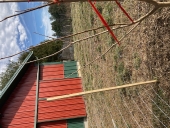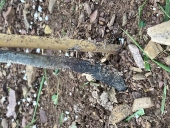


Phil Stevens wrote:I don't know how strong the branches are on this variety, but our Fuyu takes a beating from the wind and we lose a couple of branches almost every year. It's most susceptible in the autumn as the fruit are starting to put on some size and the leaves are still attached. The tree is in one of the most sheltered spots on the property but I think it's the turbulence that gets it. As fruit trees go these seem a bit delicate to me...our apples, pears. cherries and plums out in the more exposed orchard get more wind and suffer a lot less breakage.
All this is to say that having good structure is likely to be important if you get any windy weather during the growing season. Don't let any weak crotches form, and don't let new branches get too long to keep leverage to a minimum.



Dennis Bangham wrote:I suspect the graft is where the thicker root stock connects to the thinner cultivar.
